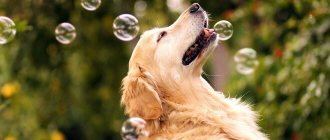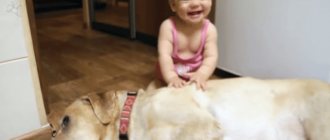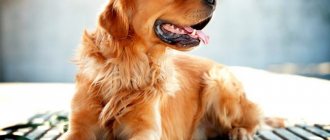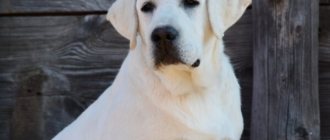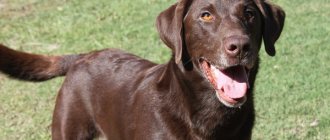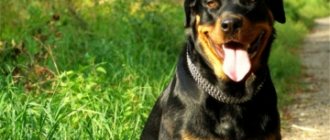The Labrador Retriever is a breed that was bred for hunting. The prefix “retriever” means that a dog helps a person get game from thickets, rivers and swamps. Labradors have a special “soft” grip. They do not tear or chew shot prey.
Over time, the scope of use of Labradors has expanded. Dogs serve in the Ministry of Emergency Situations, the Ministry of Internal Affairs and other government agencies. They search for drugs, explosives and perform rescue operations. A striking example is a Labrador named Kefir, who helps sappers clear residential buildings in Syria.
Story
Canada is considered the birthplace of Labradors. The first representatives of this breed lived on the island of Newfoundland, helping local fishermen. Labradors arose from the systematic crossbreeding of setters, curly-coated retrievers and foxhounds.
At the end of the 19th century, the breed was described and standardized. The beginning of the 20th century - Labradors were included in the registers of the English Kennel Club. In 1941, the National Retriever Club appeared in the USA. Labradors came to the USSR in the early 1970s.
History of the breed
Debates still rage about how Labrador got to the Canadian island of Newfoundland. What is known for certain is that it was there that they began to use unusual dogs that incredibly love water and enjoy splashing in it.
Mostly fishermen lived on the island. Every day they practiced their difficult craft, and unusual dogs called Newfoundland dogs helped them in this. There are two known breeds that lived on the island - large and small. Large dogs had long, thick hair, and the hair of small dogs had unusual water-repellent properties. It was this second variety that became the ancestor of Labradors. At that time, the breed was simply called St. John's dogs (from the capital of the province of Newfoundland). All day long the dogs helped catch fish, searched for nets, pulled out fallen prey and brought it to their owner. Later, Labradors began to be used as rescue dogs. So it was considered important to take at least one Labrador on a voyage. In the event of a shipwreck, the dog swam ashore, holding a rope in its teeth, along which fishermen climbed out of the sea.
In the 19th century, dogs began to be exported from the island to the United States and Europe. In European countries, breeding of the breed was difficult, since the exported dog had to undergo a six-month quarantine.
However, despite the difficulties, the Labrador took root in Europe, and later came to Russia. At the end of the 19th century, the first breed standard was adopted, exhibitions began to be held and clubs were created.
Character traits
The dog has a good-natured and playful disposition. The Labrador does not show aggression towards adults, children and pets (with the exception of birds, which the dog considers to be game). The dog loves company and does not tolerate loneliness well. Lack of attention can lead to the dog starting to look for “entertainment.” The toy could be your pillow, shoe or glove.
The dog has a high level of intelligence and innate intelligence. Some doctors use Labradors in the treatment of children with autism, cerebral palsy (cerebral palsy), and people with Down syndrome.
The dog requires regular walks and exercise. The animal's love of life and optimism create a positive psychological atmosphere in the family. For many private breeders, the Labrador has become a companion and loyal friend.
Labrador content. Walk
Anyone who is planning to take a puppy of this breed into their home must take into account that this is a fairly active dog for people with the same position in life. Representatives of this breed are suitable both for living in the city and for keeping in a private house with a plot.
“For this breed, the most important thing is that there is a person nearby, so it doesn’t matter at all where this all happens: outside the city or in the city. The only thing that those who are going to buy a Labrador need to take into account is that he needs a long walk to maintain good physical shape, you need to be prepared for this,” warns Marina.
However, sometimes half an hour can be enough for a full walk if you spend it usefully playing with the dog, thereby forcing it to splash out the accumulated energy and spend the calories it has eaten, which is very important, because Labradors can be prone to obesity and their weight needs to be maintained under control. Regarding games, everything is very individual. Some people like frisbees and pullers (this is a special rubber ring), some balls, some ropes. Many dogs literally go crazy from the dot left by a laser pointer (here you need to be extremely careful not to get the beam in the eyes). All this will fade into the background in any case, because between toys and a person he will always choose the latter.
Adult dogs usually go for walks twice: in the morning and in the evening; if desired, you can also take them out at lunchtime to brighten up your pet’s leisure time and not keep him confined to four walls all day. Ideally, if time permits, it is better to extend the walk for an hour or two.
Long exercise will bring pleasure to these “energizers” in absolutely any weather. They do not need special clothing - their thick undercoat will prevent them from freezing. Unless it makes sense to buy a raincoat that will protect the wool from dirt and save you from unnecessary washing. During the cold season, some owners try to put special boots on their paws to protect their paws from reagents, but rarely do any shoes last long on an active Labrador.
If you live in a country house, then the first thing you need to understand once and for all is that this dog is strictly not a street dog! A Labrador will not be able to live outside in a kennel. And even a warm enclosure is not his story. This breed is only suitable for living in a house, next to a person, but not outside.
photo from the personal archive of Marina Radostnaya /
Subtleties of training
You need to start raising a dog from an early age. The Labrador has a good memory and can learn several hundred words. It is enough to repeat the command several times, and the dog will remember it for life. The desired behavior must be reinforced with a treat (Labradors love to eat tasty food).
Training is best done before starting the feeding process. It is necessary to take breaks between exercises; the dog needs proper rest. New commands should be given only after the dog has mastered the previous material.
The trainer must have patience and persistence. The dog is highly mobile and can be distracted from the learning process. Training should begin in a quiet place. As you master the simplest commands, you can add various distractions (noise, presence of people and animals). Short commands must be spoken in a confident, commanding voice. The training process must be systematic. Training should be carried out 2-3 times a day. The duration of one lesson should be 15–20 minutes.
There are a number of actions that must be stopped. These include:
- Bites.
- Begging for food.
- Chewed household items.
- Going to the toilet in the wrong place.
- Picking up food from the floor.
- Attempts to climb onto a bed or table.
The Labrador completely trusts its owner and strives to please him in everything. That is why the animal should not be beaten. The dog will withdraw into itself and stop responding to the trainer’s commands. The strongest punishment for wrong actions is a slight tug on the leash and a condemning intonation. Screaming while interacting with an animal is not allowed.
Labrador breed standard: characteristics
The Labrador breed standard regulates controversial issues and accurately indicates the external and psychological characteristics of this breed.
The main breed feature of the Labrador is the tail. It should look very similar to an otter's tail.
- General form . A large dog with a wide skull and a strong body. Characterized by active behavior and balance.
- Behavior . Frisky, active, without any aggression. He is very obedient to his master and strives to please him in everything.
- Head . There are no cheeks, the transition from the forehead to the muzzle is clearly defined. The muzzle is powerful, but not sharp. Eye color can be dark brown or hazel. Drop ears are set far from the muzzle.
- Frame . Wide chest, straight back. The whole body is large and strong. The tail is thick at the base and tapers towards the end. It is covered with short, coarse hair.
- Paws . Smooth, strong, with developed pads.
- Wool . Dense wool with an interesting undercoat that has water-repellent properties. The color can be black, brown (from light to dark chocolate), fawn (from beige to red).
Adult dog size
The Labrador is a fairly large, but not huge dog. So the male has a height of 56-57 cm, and the female - 54-56 cm. As you can see, the range of acceptable sizes is small. The same cannot be said about the weight of a purebred dog. So a male can weigh from 30 to 36 kg, and a female - 27-32 kg. Labradors are prone to obesity, so it is necessary to take a competent approach to the preparation of their diet.
Lifespan
Like all large dog breeds, Labradors do not live very long. It is believed that this dog lives for a minimum of 10 years, and the maximum threshold is 13-14 years. Both the duration and quality of life directly depend on nutrition, lifestyle, active physical activity, timely observation by a veterinarian, and timely vaccination.
Nutritional Features
The main product in a Labrador's diet should be meat. The dog can be fed boiled horse meat, beef or lamb. Fatty pork should not be given to an animal; it can interfere with liver function. The Labrador needs to be periodically given boiled offal (liver, kidneys, heart, udder, stomach, etc.). They are rich in essential amino acids, iron, zinc and phosphorus. You can also include boiled low-fat fish (hake, cod) in the menu, which must first be cleaned of bones.
In addition to meat and fish, the animal should be given the following products:
- Porridge (rice, buckwheat, millet, oatmeal, pearl barley).
- Low-fat cheese.
- Cottage cheese.
- Kefir, curdled milk, bifidok.
- Vegetables (zucchini, cabbage, carrots, pumpkin).
- Fruits (apples, pears, etc.).
- Fresh greens.
The dog must have constant access to clean water. It is advisable to change it twice a day. You should not give your animal cold water; it is better to warm it up a little first.
Conditions and care for Labrador
Retrievers love water treatments. A Labrador should be bathed once every three months. The dog's fur needs to be washed twice with a special shampoo. After bathing, the resulting foam must be thoroughly rinsed off so that it does not irritate the animal’s skin.
Clean Labrador hair is wiped dry with a towel and combed with a special comb. The animal's ears should be wiped with a damp cloth once a week. It is not recommended to use cotton swabs and sticks for this purpose. If an unpleasant odor appears from your dog’s ears, then the dog must be taken to the veterinarian.
Check your Labrador's mouth daily. Brush your dog's teeth with toothpaste and a soft brush. Labradors love to chew on everything and can damage their teeth. Do not attempt to remove foreign bodies stuck between your pet's teeth yourself. This should only be done by a doctor. The animal needs to have its nails trimmed twice a month. The Labrador should have a spacious bed, located away from passageways and heating systems.
Labrador health
Representatives of the breed are distinguished by endurance, agility and great physical strength. Dogs tolerate low temperatures well and love to swim. With proper care, a dog can live 12–13 years.
Labradors may be susceptible to the following diseases:
- Joint malformations (hip and elbow dysplasia).
- Progressive retinal atrophy.
- Cataract.
- Osteochondrosis.
- Cardiovascular pathologies.
- Epilepsy.
- Dermatitis.
At the age of 2 months, the puppy is vaccinated against rabies, hepatitis and leptospirosis. Vaccination must be carried out every year. A dog that is not vaccinated against rabies will not be allowed to participate in exhibitions and competitions. Unvaccinated animals are not allowed abroad. You will not be able to take your pet on the trip.
Care and maintenance
The ideal habitat for Labradors is a country house. If you live in an apartment, remember that this animal needs long walks and do not leave the dog alone for a long time. Failure to comply with these rules threatens the Labrador's destructive behavior.
Labrador is a strong and active animal that absolutely loves water. If you have a pond nearby, then you have an ideal walking area. It is worth remembering that the pond should be shallow, so that the dog can easily find a place where it can go ashore.
The water-repellent properties of wool make it easier to care for. A weekly brushing of the coat and undercoat is sufficient to remove dirt and dead hairs.
It is very important to take care of your pet's ears. Floppy ears are susceptible to infections, so check them regularly to ensure they are clean and free of parasites.
To avoid damaged furniture and shoes in your home, buy toys for your Labrador. Use a separate toy for training. The animal will know what can be chewed and what cannot.
Labrador Retrievers are predisposed to certain diseases, which any owner should know about in order to promptly seek help from a specialist.
- Bloating . For prevention, it is necessary to adhere to the correct diet and nutrition regimen.
- Obesity . Labradors are naturally active, but lack of exercise and fatty foods pose a threat to the dog’s health.
- Joint dysplasia . It is found in both the hip and elbow joints.
- Epilepsy.
- Eye diseases . The most common are retinal degeneration and cataracts.
- Skin diseases . There may be dermatitis, pododermatitis.
- Allergy . Take into account the individual characteristics of the animal when creating a menu.
- Perianal fistula.
- Oncology . Such diseases include sarcoma, breast cancer, and lymphoma.
Don’t forget about vaccinations as an important component of preventing diseases in your pet. Your veterinarian will select the most suitable vaccination system for you.
Pros and cons of the Labrador Retriever breed
Advantages of the Labrador breed:
- Cheerful and positive character.
- Ease of maintenance and care.
- High intelligence, quick learner.
- The desire to please the owner in everything.
Minuses:
- It is impossible to use the dog as a guard (the Labrador does not show aggression towards strangers and does not defend its territory).
- The dog's craving for garbage and the desire to taste inedible objects that lie on the street.
- Tendency to overeat, excess weight.
- Abundance of hair during molting.
- Possible allergies to food and feed.
How to feed Labradors
As a diet for a Labrador, you can use ready-made complete food or natural food. In this case, it is better to first consult with the breeder so that the dog at least at first receives the food that is familiar to him. Afterwards, if necessary, gradually change your diet.
The first option is simpler, because manufacturers of high-quality feed make sure that animals receive all the necessary nutrients and nutrients. At the same time, you can choose your own nutrition options for puppies and adult animals, bitches during feeding and lactation. And special veterinary lines include products made for animals that suffer from food allergies or other diseases.
As for natural nutrition, it must contain meat, offal and vegetables. Of course, such a diet is more varied, but requires more labor on the part of the owner.
Labradors are prone to obesity Labrador Retriever. Excess weight can appear due to the fact that the dog leads an almost sedentary lifestyle and does not walk much, or simply due to overfeeding. As a result, the dog may develop serious health problems, developing diabetes, arthritis and cardiovascular diseases.
You should not treat your animal with food from your table.
Hot, smoked, salty, pickled, spicy and sweet dishes that are familiar to us will not benefit the dog.
Remember



